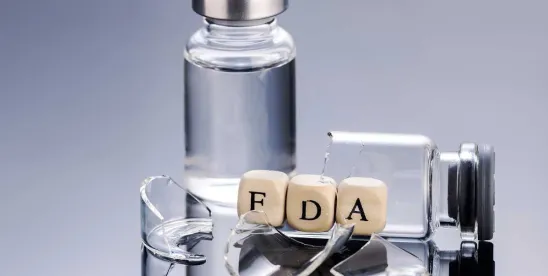On March 31, 2025, Judge Sean D. Jordan of the U.S. District Court for the Eastern District of Texas ruled that the Food and Drug Administration (FDA) lacks the statutory authority to regulate laboratory developed tests (LDTs).[1]
The court’s judgment vacates the agency’s controversial final rule of May 6, 2024 (“Final Rule”), regulating LDTs as medical devices—just weeks before the Final Rule’s initial implementation deadline—and remands the issue back to FDA for further consideration.
The two cases that were the subject of the ruling were filed shortly after FDA’s issuance of the Final Rule. In American Clinical Laboratory Association et al. v. FDA, and Association for Molecular Pathology et al. v. FDA, the plaintiffs challenged the Final Rule under the Administrative Procedure Act (APA).[2] Notably, the strength of the plaintiffs’ cases was enhanced when, on June 28, 2024, the U.S. Supreme Court issued its landmark decision in Loper Bright Enterprises v. Raimondo, overruling the long-standing Chevron doctrine. Under Loper, courts considering challenges to agency action under the APA must now exercise their independent judgment in deciding whether an agency has acted within its statutory authority, rather than deferring to an agency’s interpretation of an ambiguous statute, as had been the prevailing rule under Chevron.
The impact of that decision was not lost on U.S. District Judge Jordan, who—like the Supreme Court in Loper—noted that this exercise of independent judgment “is rooted in the ‘solemn duty’ imposed on courts under the Constitution to ‘say what the law is.’” Reiterating Loper’s directive that courts use “‘all relevant interpretive tools’ to determine the ‘best’ reading of a statute; a merely ‘permissible’ reading is not enough,” Judge Jordan’s 51-page memorandum opinion and order granting summary judgment to the plaintiffs explores the history of LDTs, their regulation over time, and, more broadly, FDA’s historical regulation of medical devices. The order also explores why the text, structure, and history of the federal Food, Drug, and Cosmetic Act (FDCA) and the Clinical Laboratories Improvement Act of 1967 and 1988 Amendments (CLIA) support the court’s conclusion that the Final Rule is unlawful.
Part One: History
Judge Jordan’s order noted that FDA began regulating medical devices in 1938 with the advent of the FDCA: “FDA was authorized to regulate ‘foods,’ ‘drugs,’ ‘devices,’ and ‘cosmetics,’ all of which were physical products that were mass-manufactured and commercially distributed.” The Medical Device Amendments of 1976 (MDA) expanded FDA’s authority to regulate devices so that unless exempt, the agency must grant one of three types of premarket authorization before any new medical device can be commercially distributed, based substantially on a device’s classification, risk profile, and marketing history. Focusing on the terms used in the FDCA to define a medical “device” subject to its authority—namely those describing a device as an “instrument,” “apparatus,” “implement,” “machine,” “contrivance,” “implant,” “in vitro reagent” and “article”—the court determined that each term refers only to a tangible, physical object and does not include intangible services.
By contrast, the order states that CLIA, not the FDCA, governs laboratory test services: “A[n LDT] is a methodology or process by which a laboratory generates biochemical, genetic, molecular, or other forms of clinical information about a patient specimen for use by the treating physician … [LDTs] are offered as services.” CLIA is administered primarily by the Centers for Medicare & Medicaid Services (CMS). Although the court acknowledged that FDA had claimed authority to regulate LDTs as medical devices starting in the early 1990s, and although FDA has relied on its claimed authority on several occasions on a case-by-case basis throughout the years (e.g., through sending FDA warning letters to clinical laboratories), the 2024 Final Rule was its first attempt to establish binding, industry-wide regulations for LDTs. Similarly, the court noted that since CLIA’s 1988 amendments, Congress has considered several pieces of legislation that would have overhauled the regulatory framework for LDTs, including certain bills that would have expressly regulated LDT services as medical devices subject to FDA’s oversight. However, to date, Congress has declined to pass any such legislation. As such, the court concluded that FDA is bound to the current statutory framework and cannot impose regulations that would circumvent it.
Part Two: Text and Structure
After finding that the laboratory plaintiffs had standing to sue—owing to the potential for injury by the Final Rule’s “massive compliance costs … often amounting to hundreds of thousands or millions of dollars per test”—the court’s order concluded that the “text, structure, and [additional] history of the FDCA and CLIA” precluded expansion of FDA’s authority to regulate LDTs as medical devices. In particular, the court noted the following:
- The FDCA’s text is clear that the “devices” within its purview do not include professional medical services, which include LDTs.
- FDA has no authority to expand or alter the FDCA’s definition of “device.”
- The Final Rule’s regulation of in vitro device (IVD) test systems made by laboratories improperly collapses the distinction between test kits and testing services. Specifically, the court explained that a laboratory test kit made by a laboratory for commercial distribution is a device, but when laboratory professionals use a series of tools to perform a test, or develop new test protocols that call for the use of such tools, they are conceiving and carrying out professional services.
- An examination of various canons of statutory construction confirms that LDT services are not “devices” under the FDCA.
- The statute as a whole “repeatedly and consistently refers to the making of devices as ‘manufacturing,’” which is distinct from professional services.
- The FDCA and the MDA were not enacted to regulate clinical laboratory test services.
- CLIA’s 1988 amendments, passed after the MDA of 1976, created a detailed statutory framework to govern clinical laboratories.
- The FDCA’s relevant text, being unambiguous, cannot support FDA’s “untenable” interpretation of the FDCA to include LDTs as detailed in the Final Rule.
Notably, the court also determined that FDA’s assertion of its long-standing authority to regulate LDTs as medical devices turns on the assumption that the laboratory industry has been operating for decades “in open and direct violation of the law.” FDA’s continued exercise of enforcement discretion for many categories of LDTs, as expressed in the Final Rule, would result in the industry continuing to operate going forward at substantial risk of civil and criminal penalties if FDA decides to curtail its policy of enforcement discretion. In rendering its ruling, the court declined to accept an interpretation of FDA’s authority under existing law that would result in that outcome and would require many years and an implausible level of administrative effort and resources to bring the industry into compliance with the Final Rule.
What Happens Now?
As we explained in our 2024 blog post, the Final Rule would have required virtually all clinical laboratories that offer their own LDTs to come into compliance with FDA’s expectations for medical device manufacturers in phases over a four-year period. The Final Rule provided for different levels of enforcement discretion for certain LDTs that were on the market prior to May 6, 2024; LDTs that are approved by the New York State Clinical Laboratory Evaluation Program (CLEP); LDTs for unmet needs manufactured and performed by labs integrated in a health system; and others. Yet it still required all labs, regardless of enforcement discretion category, to comply with Phase 1 and Phase 2 implementation requirements. Phase 1 requirements included implementation of Medical Device Reporting requirements, correction and removal reporting requirements, and quality systems requirements under 21 C.F.R. § 820.198 (complaint files), beginning on May 6, 2025. In Phase 2, laboratories were required to comply with establishment registration and device listing, labeling, and investigational use requirements, beginning on May 6, 2026. Those mandates, and others that were supposed to follow in Phases 3, 4, and 5 to the extent applicable (including, notably, submission of product applications to FDA by November 6, 2027, for high-risk tests and by May 6, 2028, for all other tests), are no longer enforceable. As the March 31 order states, data suggests that the Final Rule would have affected about 1,181 existing laboratories, resulting in the need for submission by laboratories and the review by FDA of approximately 10,013 new tests each year. Implementation of the Final Rule would have imposed major burdens on many laboratories that will, now, no longer apply.
The vacated and remanded Final Rule now goes back to FDA for further consideration, and the laboratory plaintiffs’ motions for summary judgment are granted. Yet as we noted in our April 1 blog post, the judge’s conclusions that (1) “the [FDCA]’s relevant text is unambiguous and cannot support FDA’s interpretation” and (2) “FDA’s asserted jurisdiction over laboratory-developed test services as ‘devices’ under the FDCA defies bedrock principles of statutory interpretation, common sense, and longstanding industry practice”—leave little to no room for FDA to salvage its effort to regulate LDTs broadly under existing statutory authorities. While still a possibility, the legal arguments relied on by the court and the post-Loper legal landscape suggest that an appeal of the court’s order is unlikely to be successful. Perhaps more likely would be future congressional action. Therefore, stakeholders and advisors should keep an eye on news coming from Capitol Hill.
Looking to the Future of FDA’s Role in LDTs
Although, absent an appeal of the court’s order, this chapter of the decades-long LDT saga may be winding down, FDA has not yet been written out of the story. Even though the court decided that FDA cannot regulate LDTs under existing law, it, of course, acknowledged that the FDCA provides FDA with authority to regulate device “articles” in interstate commerce. While it remains to be seen whether the current administration has an interest in, or if FDA will have sufficient remaining personnel and resources to effectuate, an increase in oversight of laboratory industry stakeholders, FDA could enhance its reliance on its existing authorities to exert oversight of several aspects of the laboratory industry even if it is unable to regulate LDTs directly.
Enhanced Oversight of Specimen Collection Kits and the Laboratories That Distribute Them
Existing device authorities continue to allow the FDA to reach many of the articles that labs rely upon to provide LDT services. For example, FDA regulates specimen collection devices. As a result of the court’s vacatur of the Final Rule, FDA could, in theory, seek to more aggressively enforce these authorities. Occasionally in the past, FDA has taken the position that a lab distributing specimen collection kits for use with its LDTs resulted in violations of the FDCA if the collection kits had not been cleared by FDA for use with the LDT. Of note, FDA has exercised enforcement discretion for what the agency calls “convenience kits” since 1997, taking the position that multiple articles packaged together are not subject to premarket review requirements if they all are in their respective original packaging and are intended for use consistent with their respective labeling. While the enforcement discretion allows such kits to forego premarket review, the kit assembler still must register as a manufacturer and list the kit product with FDA. Thus, if a lab assembling and distributing such a kit fails to follow that registration process, the lab could be subject to agency scrutiny. Also, if a component of a kit is only FDA-cleared for specific uses (e.g., use with specific FDA-cleared tests), manufacturing and distributing a kit intended for use that is not consistent with those uses (e.g., use with a non-cleared LDT) might be argued by FDA to result in commercial distribution of an unapproved and misbranded collection kit. FDA could use these and similar approaches to restrict access to LDTs, discourage their use, or try to persuade laboratories to share information about test performance in order to secure clearance of their test kits
Enhanced Enforcement Against Manufacturers and Distributors of Laboratory Reagents and Equipment
Another approach FDA has taken to indirectly regulate LDTs is to threaten enforcement against manufacturers and distributors of laboratory equipment, reagents, and other FDA-regulated articles when they view those entities as inappropriately supporting the development of LDTs using their devices. Manufacturers may be subject to FDA enforcement if their support or advice to a clinical laboratory regarding LDT development is deemed by FDA to be evidence that the products they provide to a clinical lab are intended for unapproved uses. As a result, barriers remain regarding communications between laboratories and manufacturers of equipment used to perform LDTs, such as analyte-specific reagents, instrument platforms, and research-use-only products. Though there are mechanisms for “scientific exchange” under some FDA guidances, the means of communication, who can communicate, and what they can say about medical device products used in the performance of LDTs impose significant limitations and hinder more organic collaborations between product manufacturers and labs that could potentially aid in optimizing LDTs.
Therefore, even in the absence of an FDA regulation that directly regulates their laboratory testing services, it is important for laboratories and their component suppliers, as well as others collaborating with labs to provide direct access testing services, to consider how they mitigate risks of potential FDA enforcement going forward, whether on a case-by-case basis or as part of a broader initiative. As to broader initiatives, with the recently added “suggestion box” on Regulations.gov for areas that should be considered for deregulation, an opportunity may have arisen for stakeholders concerned about these issues to coalesce around proposals that would support access to components and collaboration in LDTs going forward with fewer restrictions.
What Else Could the Future Hold?
It is important to appreciate that nothing in the court’s order prohibits the Executive Branch from pursuing changes to how it regulates LDTs in the future. The order only appears to prohibit the government from establishing a regulatory regime for LDTs under its FDCA authorities. CLIA continues to govern clinical laboratories and their testing services and, like the FDCA, vests authority for regulation with the Secretary of the Department of Health and Human Services (HHS). The Secretary has historically delegated authorities further to HHS’s subagencies FDA (for the FDCA) and CMS (for CLIA). However, some states (like New York) have implemented an LDT-specific review and approval process under their own clinical laboratory regulatory regime (e.g., CLEP, which is approved by CMS as satisfying CLIA requirements in New York). It is not beyond reason that some other states could decide to follow suit in the wake of this development.
To proponents of the Final Rule, one of its virtues was to provide parity in terms of the performance requirements and premarket review of the development of laboratory tests. The idea was that whether a laboratory test for a given disease was an IVD or LDT, it would (i) need to meet similar standards with regard to analytical and clinical validity and performance, and (ii) be subject to a similar level of review to demonstrate that those standards were met. FDA’s preference was that tests go through the FDA regulatory process to achieve this goal, but that’s not what parity requires. Parity in this context could be achieved by other means of ensuring that IVDs and LDTs receive comparable treatment, e.g., establishing the clinical validity of a new diagnostic test marker should require the same amount of data whether the test is an LDT or IVD, or that tests should be held to the same requirements for sensitivity and specificity if they have the same indicated use. Although there are differences in the manner of test production (e.g., manufacturing concepts in an IVD plant versus LDT assembly in a clinical laboratory), the idea that both kinds of tests should meet the standard for analytical and clinical validity and performance because the results—regardless of test type—will have the same potential clinical impact on patient’s clinical care does not lose its appeal from a parity perspective simply because FDA lost a court case.
HHS itself could potentially move to establish comparable standards and requirements for IVDs and LDTs by relying on both its FDCA and CLIA authorities—perhaps reaching a middle ground between the current FDA and CMS approaches. Under the previous administration, just before issuance of the Final Rule, FDA and CMS issued a joint statement aligning on their respective roles in the regulation of LDTs, so it will be interesting to see whether an update to that position will be released. Epstein Becker Green will continue to monitor whether there will be further efforts toward greater parity between test requirements.
ENDNOTES
[1] Memorandum Opinion and Order, American Clinical Laboratory Association et al. v. U.S. Food and Drug Administration, No. 4:24-CV-479-SDJ (E.D. Tex. Mar. 31, 2025).
[2] These cases were subsequently consolidated for review by the Texas district court, which considered the parties’ cross-motions for summary judgment.






 />i
/>i

